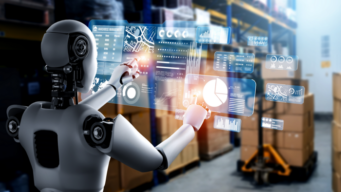In recent years, the manufacturing sector has experienced notable disruptions – including supply chain instability, product demand fluctuations, transportation issues, and workforce shortages. However, amidst these challenges, a crucial lesson emerged that highlighted how harnessing information effectively can yield a distinct competitive edge and enhance overall profitability.
As we anticipate the forthcoming year, here are my five industry predictions for the next 12-months:
AI enabled digital twins
Manufacturers have been building digital twins of their products and physical production environments for a few years now. In fact, digital twins have been used as part of the product design process for nearly 30 years, with the aim of removing the need for physical prototypes. The emergence of generative AI will transform how users interact with their digital twins. The manufacturing industry has a technological perfect storm ahead of it in 2024 as companies look to leverage the benefits of IoT, AI, Augmented Reality, and 3D engineering models. Generative AI will allow engineers and maintenance teams to literally have conversations with their products. The ability to monitor, control and adjust physical equipment through a 3D virtual representation will transform through life support models. AI will learn through the digital twin as to how the physical model should be operating in real life and based on historical data will be able to fine tune the physical equipment for optimum performance. We are just learning about the potential for generative AI, and 2024 could be a transformational year for the technology in the manufacturing industry
Sewing a digital thread through manufacturing information systems
The manufacturing industry is the most global of industries and yet it struggles to ensure that information is accessible anytime and anywhere around the world. Part of the problem is that manufacturers use multiple systems, from ERP, PLM, WMS, TMS and B2B integration solutions to digitize the supply chain. In 2024 we will see more extensive digital backbones being introduced across global manufacturing operations which in turn will allow digital threads to be established between manufacturing, engineering, and process-based information systems. Companies have struggled for years with siloed information but digital threads, through a combination of APIs and other application integration technologies will allow information to be exchanged seamlessly between different manufacturing systems. Digital threads will be critical to the successful deployment of an AI based solution as to obtain real time insights into manufacturing operations as all information needs to be aggregated into a central data lake for processing and analysis. Digital threads will provide manufacturers with the ability to extract valuable insights into their operations and allow processes to be optimized to meet customer and market demand.
Accelerated exploration of the industrial metaverse
Virtual Reality (VR) technologies have been around since the 1990s but has seen mixed adoption in the enterprise. This is mainly down to the technology used to project the 3D environments but also identifying valuable use cases for where the technology can be used. Augmented Reality (AR) has seen an accelerated interest during 2023 with the service support sector leveraging the technology for maintenance purposes. Meta quietly introduced the Metaverse nearly two years ago now and received a mixed reception. However industrial companies have been exploring interesting use cases for the technology. Taking industrial digital twins into the Metaverse will likely accelerate in 2024 as companies realise the benefits of using the Metaverse to test digital mock ups of products, to train service technicians in how to maintain complex equipment and for business leaders to test certain ‘what if’ scenarios to see how their business or supply chain operations will perform. There is a debate as to whether VR or AR will succeed but it really depends on the use case and which technology users feel most comfortable using. The Metaverse will likely define a new form of content management system as each 3D object will have data and other assets associated with it that will need to be managed in an efficient way.
Embracing ESG and SCOPE 3 emissions mandates
Consumers are forcing manufacturers to rethink how they design, build, and maintain their products. Manufacturers are starting to embrace the Circular Economy by designing new products so that they can be recycled more easily at end of life. Being able to monitor all processes and all external trading partners for ESG compliance will accelerate in 2024, especially as more countries follow Germany’s lead on ensuring that companies are accountable for how they source materials and goods to produce finished products. Developing more sustainable products and processes has been on the increase in recent years but consumer interest in knowing what goes into manufacturing today’s products is forcing manufacturers to comply with new ESG regulations. Manufacturers will become more accountable for emissions not only being produced by themselves but by their multi-tiered supply chains and the logistics carriers transporting raw materials to factories and finished products to their customers. Connecting all trading partners to a common business network will potentially help to track emissions across the supply chain but it may require new EDI document standards to be developed to allow emission values to be captured at each stage of the supply chain process. The technology is certainly available to help improve the monitoring and tracking of ESG and SCOPE 3 emissions and 2024 will see new supply chain technologies and processes emerge to achieve this.
Migration to industrial clouds
As manufacturers continue to globalize their operations, they need to connect to a central information management system to ensure they can access any digital asset as required. Manufacturers have been migrating to the cloud for many years but in 2024 we will see industry specific clouds accelerating across different sectors. So, whether you are operating in the automotive, high tech or process sectors, new industry-based clouds will appear that contain pre-built adapters to allow you to seamlessly integrate with any ERP, PLM or B2B environment. They will contain pre-defined process templates to ensure that information flows according to specific business rules used by a particular industry. Finally, they will embrace all the necessary standards to operate effectively in each industry, whether that is embracing ODETTE supply chain standards in automotive sector or IP protection regulations in the high-tech sector. Industrial clouds will transform how companies archive, integrate, and derive insights from industrial information flowing across their internal and external business ecosystems.
A prevailing theme knitting these predictions together unsurprisingly lies in the significance of technology within the manufacturing sector. As the industry continues to advance through its digital transformation, groundbreaking technologies – such as artificial intelligence, machine learning and the Metaverse – are poised to take centre stage. To maintain competitiveness, the manufacturing sector must expedite the adoption of these technologies and take a proactive approach in navigating the evolving landscape of modern manufacturing.
Learn more about how OpenText solutions for the manufacturing and automotive industries can help your organization overcome its challenges.




